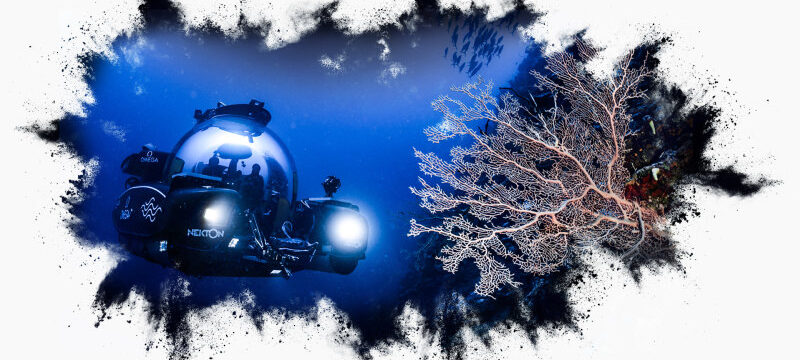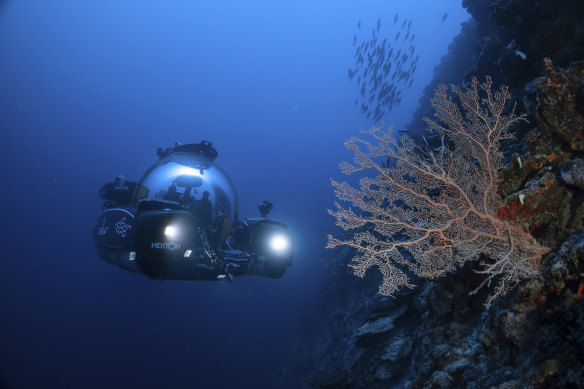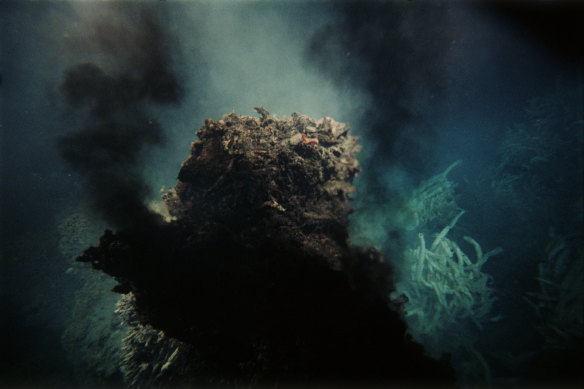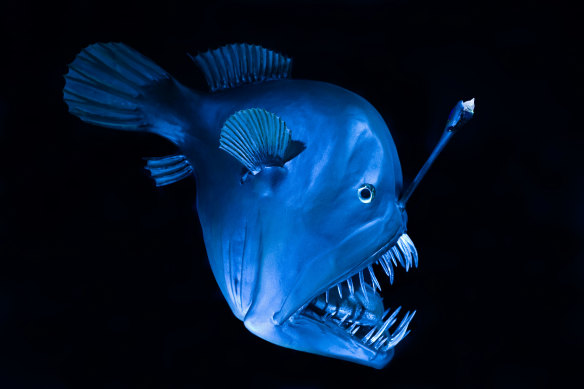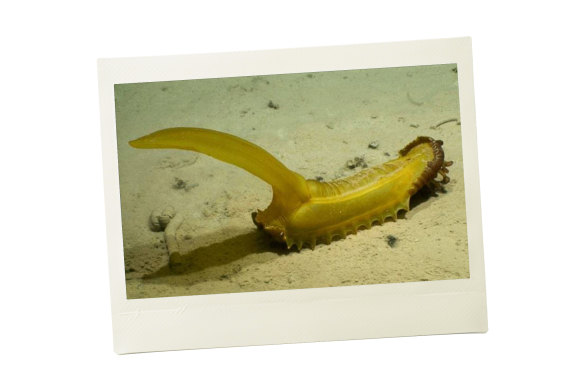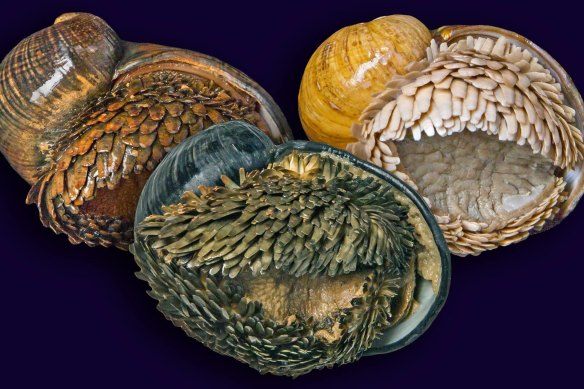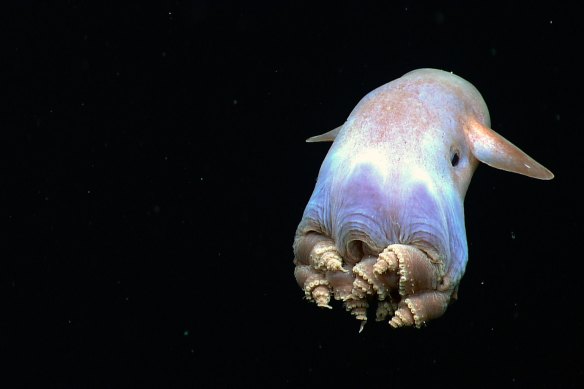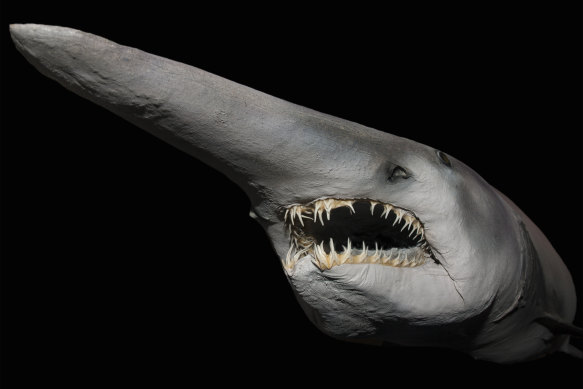As scientists find wonders on the deepest seabeds, miners and governments are looking at other riches – metals used in green technologies. What’s at stake way down beneath the waves?
Save articles for later
Add articles to your saved list and come back to them any time.
Nine years before the moon landing, an engineer and a navy lieutenant piled into a submersible chamber the size of a refrigerator to boldly go where no one had gone before – not up to the stars, but down to the deepest point in the ocean. Eleven kilometres down the Mariana Trench. That’s deeper than Mount Everest is tall.
There are mountains under the sea too, and volcanoes that burp out giant lava bubbles. There are armoured spider crabs with legs more than three metres long, 200-year-old sharks and yes, giant squid. Really, the deeper you go, the stranger it gets.
Back in 1960, it took the little submersible nearly five hours to reach the bottom. Explorers Jacques Piccard and Don Walsh had taken only chocolate bars as snacks for the eight-hour round trip. And out the windows the pair saw life, even in the deepest waters, creatures gliding in darkness.
Nearly three-quarters of our planet’s surface is covered by ocean yet we have still explored only about 10 per cent of it. That’s because so much of the sea is deep, a dark realm of such extreme conditions it’s where NASA tests the technology it will take to other planets. (The 1960 submersible sent into the Mariana Trench used a clever “rebreather” life support system later adopted by spacecraft.)
In June, the world was reminded just how dangerous this underwater wilderness can be when tragedy struck: a private submersible journeying to the Titanic wreck, nearly four kilometres down in the Atlantic, imploded, killing all five people on board.
Still, today many are eager to open the deep for business. This sunken scape is also home to metals now sought after for electric car batteries, wind turbines and mobile phones – in the crusts of cobalt on undersea mountains, in towering hydrothermal vent spires of copper and gold, and in ancient potato-sized polymetallic nodules on the seafloor. As countries and corporations stake claims, scientists warn not enough is understood about the risks – they say dredging up the deep could wipe out ecosystems crucial for our planet.
So, what would mining mean for the deep sea – and us? And what’s down there anyway?
First, what’s down in the deep?
About 30 years after Walsh and Piccard’s descent, Australian geologist Ray Binns climbed into a Russian submersible to visit an undersea mountain. “It was just me, a pilot and an engineer, three kilometres down,” recalls the now retired Binns. “When we got back to the surface, after about 17 hours, the ship had lost us. It was five miles off course.”
Rescue did come (eventually). But what the trio saw under those waves has never left Binns. “It’s completely black. Then suddenly the seafloor appears and it’s white, like a snowfield. It was like going to the surface of the moon.” Binns, who had worked on moon rocks and also discovered Papua New Guinea’s hydrothermal vents on a voyage in 1991, actually did turn down job offers from NASA. “I nearly became an astronaut. Instead, the Russians said I became a hydronaut.”
The deep sea really does look alien, says marine biologist and explorer Jon Copley. “It’s shaped by different forces than the surface.”
There are “immortal” jellyfish tinier than a fingernail that change form and are reborn, phoenix-like, over and over. And snailfish that can withstand extreme pressures but at the surface will cook and fall apart in your hand. Entire ecosystems blossom around the hot magma that spews out of cracks in the Earth’s crust – ghostly Yeti crabs and shrimps with eyes on their backs clinging to the “lumpy hills of frozen lava”, as Copley describes it, or gushing hydrothermal vents “like hot springs under the sea”. Washed up on shore, some creatures from the deep look like monsters: whopping three-tonne sunfish and giant squid with dinner-plate-sized eyes.
One hundred and fifty years ago, the HMS Challenger trawled the deep seabed on a major exploration of the ocean, bringing up an exotic collection of rocks, creatures and coral that’s still treasured by museums around the world. It was just a taste of what’s down here. “Every dive looks different,” says Copley, who went on the first journey to the world’s deepest hydrothermal vents in 2013. “It’s just as diverse as the mountains and forests and deserts on land.”
Scientists in a deep sea submersible examine the health of coral reefs off the coast of the Maldives in 2022.Credit: Ocean Census via AP
What does the deep sea mean for us?
Biologists estimate we have yet to discover two-thirds of deep sea species – and some could help open new frontiers of science. Unlocking the secrets of immortal jellyfish and ancient bacteria, say, could help medicine conquer cancer and superbugs, or even reverse ageing.
Copley speaks of the scaly foot snail, which grows iron plates on its underside (“foot”) in the hydrothermal vents where it lives. “At spots like this, you can have 400 species found nowhere else on Earth somewhere half the size of Disney World,” says Copley. That snail also produces rare nanoparticles that scientists learned to make themselves to produce solar panels. “Until we saw how the snail made them we didn’t know how.”
Life on this planet may have begun in the darkness of the deep. And the ocean makes life at the surface possible too – its rich food chain and powerful currents drive the world’s weather (and fish stocks). The weight of the sea drags things down; it’s the world’s biggest carbon sink, compressing dead plants and animals over millennia into fossil fuels. “The deep sea is the last frontier, but it’s not an isolated box,” says ecologist Jeff Drazen at the University of Hawai’i at Manoa. “We’re still connected to it.”
If you ask some, the very key to solving climate change could lie at the bottom of the sea. Many of the rocks brought to the surface in the Challenger’s haul were actually metals – copper, zinc, cobalt and others now needed for the green energy transition. Manganese (or polymetallic) nodules are of particular interest – small, potato-shaped rocks that have formed, under intense pressure, on the ocean’s abyssal plains over millions of years. Then there are metal crusts on sea mountains. And towers of copper and gold that climb up through the deep: hydrothermal vent “chimneys” where super-hot water hissing from the Earth’s crust hits the cold ocean, igniting all kinds of chemical reactions. “We call them black smokers but they’re actually sparkly too, they glitter with crystals of iron, fool’s gold,” says Copley.
A hydrothermal vent spewing hot water, known as a “black smoker”, in the Pacific. Credit: Getty Images
Demand for metals is expected to more than double by 2060, according to the OECD, and some analysts fear shortfalls could delay the green energy transition. The Clarion-Clipperton Zone (CCZ) that stretches between Hawaii and Mexico is so studded with nodules it’s said to hold more rare metals than all the reserves on land.
Start-up The Metals Company (TMC) calls these nodules “a battery in a rock”, arguing they can be mined with less impact under the sea than on land. It says the haul from its claims in the Pacific alone could electrify 280 million vehicles. And the world can’t afford to wait.
A polymetallic nodule with a section of the top layers removed, from the Blake Plateau in the Atlantic Ocean. Credit: Alamy
Already, global warming has reached the deep sea – those huge volumes of ice melting at the poles are slowing critical deepwater currents in the Atlantic and near Antarctica. That could lead to a catastrophic breakdown in the warm waters of the Gulf Stream and fuel wilder weather at the surface. These currents also carry oxygen down from the higher ocean, taking hundreds of years to make the full journey (starting in the Arctic and ending in the CCZ). “Oxygen levels are already on track to drop by 10 per cent, on average, in the deep,” says Copley, who fears the creeping advance of oxygen “deserts” down below. “That’s already baked in.”
Some creatures, such as the vampire squid, have evolved to survive in low-oxygen waters. “But for most it’s going to push them into new parts of the ocean. Fierce Humboldt squid will end up in our fisheries as a new predator. It’ll throw everything out of whack.”
Of course, deep sea mining will stir things up itself.
A humpback anglerfish deep in the Atlantic Ocean.Credit: Alamy
How would deep sea mining be regulated?
The crew of the MV Hughes Glomar Explorer were in high spirits as they sailed from California on a special mission in 1974. “Mission impossible?” recalled one crew member. “Nonsense! ‘Impossible’ was not in our vocabulary!” The state-of-the-art ship, named after its billionaire backer Howard Hughes, was on the hunt for rare metals in the deep Pacific.
At least, that’s what everyone thought. Decades on, a declassified CIA report revealed the Glomar’s true mission: recovering a sunken Soviet submarine (and its nuclear-tipped torpedoes). But so elaborate a cover was this “advanced … deep-ocean mining” that even the Soviets, spotting the Glomar bobbing suspiciously in the sea, wished them all the best and left.
Now, half a century on, the world may be on the brink of a real deep sea mining rush. Robot rovers resembling giant bulldozers have been built and tested in the deep, trundling over the ocean floor to suck up nodules or carve off mountaintops with metal teeth. And a little-known United Nations regulator is finalising international regulations to let them start work.
Countries can mine in their own territorial waters (which Japan and Norway, for example, both look to do). But the main game is the high seas, beginning 200 nautical miles from shore, where international law rules. The deep here is simply called “the Area” by lawyers. Covering just over half the Earth’s entire seabed, it’s considered the common heritage of mankind, akin to the moon and outer space.
That means the profits from any riches beneath the waves are meant to be “for the benefit of all”, as set out in the 1982 UN Convention on the Law of the Sea. The convention created the International Seabed Authority (ISA), set up in 1994, to govern deep sea mining in the Area and divvy up profits fairly among nations. Commercial mining is not yet allowed, with country delegates still negotiating a mining code. But the ISA grants exploratory licences to countries, and to companies sponsored by governments, to prospect metal reserves, at half a million US dollars a pop.
More than 1.5 million square kilometres of international seabed, roughly the size of Mongolia, already falls under these licences, mostly in the CCZ. That zone also happens to be teeming with life. Drazen, who has visited the CCZ many times, describes dumbo octopuses with big, “ear-like” fins and “gummy squirrel” sea cucumbers that look like rubber sneakers.
A gummy squirrel in the Clarion-Clipperton Zone of the Pacific. Credit: DeepCCZ Expedition
Some small Pacific nations such as Nauru and the Cook Islands, which sponsor companies that have licences in the CCZ, argue the billions of dollars in metals beneath the waves could help lift their countries out of poverty. But others, including Fiji, Palau and Samoa, have called for a ban, worried that mining the deep could imperil the fish and sharks in higher water the countries rely on.
Long negotiations over seabed mining are coming to a head. In 2021, Nauru triggered an obscure rule giving the ISA a two-year deadline to finalise its mining code. That deadline expired in July, meaning the ISA’s powerful operational arm, the Legal and Technical Commission, can now consider and approve commercial mining licences, whether global rules are in place or not. TMC, which has partnered with Nauru, plans to apply next year, although the code is not expected to be adopted until at least 2025.
As ISA observer and environmental lawyer Duncan Currie puts it, a code is still “miles off”, with key principles unclear such as how profits will be shared among nations and companies, and what contamination thresholds will be set (the way companies have limits on river dumping, for example). Says Drazen: “We don’t have nearly enough research to set those limits.”
Scaly foot snails found in deep sea ridges near Mauritius. A nanoparticle they produce inspired scientists to make their own for use in solar panels.Credit: Chong Chen
In March, UN states agreed on a new treaty to protect the high seas more broadly: two-thirds will become marine reserves. It was a big win for conservation, nearly two decades in the making. But down in the Area, deep sea mining remains under the ISA’s remit. And a growing chorus of nations including Australia, Chile, Germany and Italy (as well as the Vatican) have raised concerns over how the ISA is governing mining prospectors.
One problem, Currie says, is that competing interests lie at the heart of the ISA, an agency with more autonomy than other UN bodies. Headquartered in Jamaica, it has a legal responsibility to safeguard deep ocean ecosystems, yet its role is also to oversee mining – an inherent tension.
Companies and governments coming to cash in on deep sea minerals are expected to pay the ISA royalties – a yet-to-be agreed share of profits for administration costs, and to divide among member states. But there are concerns the ISA’s proposed models will put most of the profit in company pockets. The ISA did not respond to questions or requests for an interview, but has previously defended its integrity and independence.
Copley notes that, for all the UN’s “utopian vision” of using the sea’s riches to correct inequality, in practice, the ISA’s reliance on private companies to actually do the mining could widen the gap between rich and poor. “Those companies don’t work pro bono. Maybe a little benefit trickles down. But a small group are still getting proportionately richer, the opposite of [the original] vision.”
A dumbo octopus uses its fins to move through the depths of the Gulf of Mexico.Credit: Alamy
What are the scientific concerns over mining the deep sea?
The nodules in deep plains such as the CCZ are as crucial to ecosystems as trees in a forest, Dr Helen Scales writes in her book The Brilliant Abyss – such as nurseries for octopuses, and hiding places for worms. “When we go down for our studies, about half of the large animals we see depend on them,” says Drazen, who has conducted baseline ecosystem research funded by TMC. “And they won’t grow back for millions of years.”
Mining the seafloor would dredge up storms of dust and mud that could spread up to 100 kilometres, according to Drazen and other experts. They could smother life, blinding the bioluminescent “stars” of the deep, and feed toxins into the wider food web, from whale sharks to swordfish. Excess seawater and mud sucked up from the seafloor with the nodules would then be dumped back into the ocean. “That might add in more fine particles of metal, as those nodules are broken up,” Drazen says. “Mercury already builds in animals naturally. Remember, your plate of sashimi is only ever one step in the food web removed from [the deep].”
Metallic nodules are also a little radioactive, and a recent paper in Nature has raised concern that alpha emitter particles could be released by deep sea mining. “They don’t penetrate the skin, so they’re not normally a problem but they can be toxic when ingested,” explains Copley, who is running UK-funded research examining the aftermath of deep sea mining tests. (Even after 26 years, local biodiversity failed to recover at one site following a 1989 mining experiment in the Pacific, for example.) “It’ll be about scale,” Copley says. “Could it be managed regionally? Maybe. But we hadn’t even considered radiation before now.”
A goblin shark, with teeth that snatch squid and octopus and its snout covered in sensors for hunting in the dark.Credit: AP
TMC and other prospective miners say they have invested millions of dollars in deep sea research and have developed technology to minimise disruption, with artificial intelligence and sensors to monitor activity down in the deep. TMC’s Australian chief executive, Gerard Barron, stresses many concerns about mining remain speculation. “People first said the sediment plume would find its way to the other side of the world, now we know it’s localised,” he says. “There will always be impact”, but compared to the destruction of land mining, he considers deep sea “harvesting” a game-changer. “We feel we have enough data” to do it responsibly, he says.
But not everyone agrees. In 2022, more than 30 deep sea experts, including four from an ISA committee, concluded there wasn’t enough data to regulate mining in the deep. Hundreds of scientists, as well as countries such as Germany, Canada, Spain, Chile and New Zealand, have called for a moratorium until further research is done (France wants an outright ban). Tech giants including Google and Samsung, and car companies BMW, Volvo and Volkswagen also back a moratorium, but Australia has so far remained silent, despite the urging of some of its Pacific neighbours.
Others say the need for seabed metals has been overhyped. Some electric-battery makers, including Tesla, are already using alternatives to cobalt and nickel. “And we have these metals on land,” says Currie. “The real issue is strategic access.” Cobalt and nickel are concentrated in places such as China and Russia, he says, and coltan (another battery metal) often involves tearing up rainforest or child labour in the Congo.
Meanwhile, China has the technology to dive into the deep sea gold rush first, says marine governance researcher Pradeep Singh, who has been on the country’s deep sea vessels. But he doubts it’s in China’s best interest to kickstart the frontier when it already has such a hold on metals on land. “If it threatens their dominance, that’s when they will jump the queue,” Singh says. Until then, he says, “they are happy to wait because whoever goes in first will have lots of technological issues, lots of legal issues.”
The tentacled Relicanthus lives off sponge stalks attached to nodules in the CCZ.Credit: Craig Smith and Diva Amon, ABYSSLINE Project.
Renee Grogan spent a decade in the Australian mining industry before joining Impossible Metals – a start-up that promises to solve some of deep sea mining’s environmental risks through clever robotics. “We’re never going to understand all the animals that live in the sediment,” she says. “So we have to engineer in a way to protect them.” Instead of dredging and sucking up nodules, the Impossible Metals prototype hovers over the seabed and uses artificial intelligence originally developed for fruit picking to check if there is life on a nodule – Grogan says the prototype will “harvest” only those that appear uninhabited.
Impossible Metals still has plenty of tests (and critics) to wade through, but if the company can prove the technology, Grogan says it will look to sell it on to prospective miners with existing ISA licences.
“Still, it’s in no one’s interest to jump the gun and start mining before the regulation is ready,” Grogan says of the Nauru trigger. And, while all eyes are on the draft mining code, she warns little attention is devoted to how it will be enforced. She points to deep sea fishing – an industry heavily regulated on paper but notoriously under-enforced due to the sheer difficulty of policing so much ocean. “We need to talk enforcement now.”
Drazen worries one of the biggest decisions for our planet’s future is today being made largely in the dark. We can stare up at the night sky and wonder at the stars, he sighs, “but we don’t think about the deep sea, even though it’s our own backyard. The public need to wake up to this.”
While Copley says he has sympathies on both sides of the debate, he keeps thinking of that scaly foot snail. “If we’d just wiped it out with mining, we’d never have learnt about the solar panels particle.” Now, the snail is the first species ever to be listed as endangered because of the impending threat of deep sea mining.
“The deep is like nature’s library,” he says. “We want to read it, not burn it down.”
Fascinating answers to perplexing questions delivered to your inbox every week. Sign up to get our Explainer newsletter here.
If you'd like some expert background on an issue or a news event, drop us a line at [email protected] or [email protected]. Read more explainers here.
Most Viewed in Environment
Source: Read Full Article
